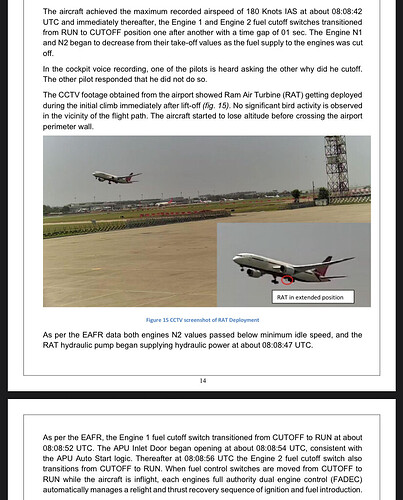A fully automated airliner with no pilots!! And incidentally, no passengers, either!
@Richard: According to the AAIB Preliminary Report (June 2025), the two fuel control switches were not moved at the same time:
- The right engine switch was moved to CUTOFF first, at about 4 seconds after liftoff.
- The left engine switch followed roughly 1 second later, at 5 seconds.
- Both engines flamed out.
- At about 15 seconds, both switches were returned to RUN—but by then, the aircraft had run out of altitude.
So, no, they weren’t toggled “at the same time.” The sequence was right first, then left, a second apart. This timing strongly suggests deliberate action by one pilot using one hand, not accidental contact or simultaneous movement.
See animation. https://www.youtube.com/watch?v=AHsQDRUCMiU&t=125s
Where do these numbers originate?
The cut off (1) happened “immediately after” 180 knots (08:08:42) which is 7 seconds after Vr.
Individual switch (1) was moved back to ON ~ 10 seconds later (08:08:52) and switch (2) following 4 seconds later (08:08:56) for a total of 14-15 seconds before both switches were back in normal operation mode.
The prelim is very hazy on the exact timeline and especially on who said what.
CA was PM and FO was PF. By the time of rotation, PF’s hands would have been manipulating the yoke and not on or near the powerlevers.
Last but not least, language spoken on the flight deck is undefined and even though available, no CVR is in known circulation. No transfer of aircraft control was recorded.
The linked video seems like a especially desperate attempt to monetize this accident.
I’m going off the timeline outlined in the AAIB Preliminary Report and echoed by multiple sources, and several aviation analysts. The sequence, right engine CUTOFF around 4 seconds after liftoff, left engine at 5, both returned to RUN at ~15 seconds—wasn’t invented. It’s been cited and discussed publicly.
My reply to Richard (anoldpilot) was focused on explaining how the switches could be moved close together in time, not claiming they were flipped simultaneously, just quickly, one after the other.
If the final report revises that sequence, fine. But for now, I’m working with what’s been documented. Not speculating. Not making anything up. Just addressing the facts as they’ve been presented. The video has good graphics and helps visualize the times and motions, that’s why I presented it.
Didn’t mean to imply anyone had “invented” anything, I just looked at the timespan between Vr (at which point PF would leave the power levers) and the actual first indication of a transition from RUN to OFF and then back on. It took 1 second or less to switch them off, but 4 seconds the other way around.
Oh well, 1-2 years from now, we’ll be wiser.
May the most popular narrative win.
So, it sounds like deliberate action cannot be ruled out yet…
260 people died. We know the engines were shut down—but not who did it or why. A cockpit video cam would have shown the hands, the switches, and the intent. No guessing, just facts.
Fully Autonomous aircraft solves this problem. It’s just a matter of time.
I am sure you are willing to give up whatever job you have to a robot, right? Fair is fair.
How do you know that? All accidents are caused by people. Right? That’s why we call them accidents and not acts of god. The automation system is made by people, not by gods.
How many millions of hours of testing have been done with a fully-automated airliner to prove that you can reduce the already unbelievably low fatal accident rate in the US of average less than ten deaths per year for about 300 million passengers?
Where is your data?
I don’t think you have enough. Perhaps someday you might.
Enter the Stig Shift #78’ (Aircraft Maintenance Adventures) gives one of the best, easiest-to-understand explanations of what happened with the FUEL RUN–CUTOFF switches and how they work with the systems.
The camera debate was mostly a side issue. What really matters, and what most of the thread focused on, is whether the system design allowed a mistake, or whether it was pilot error, and who’s responsible when things go wrong. Watching the part from time-stamp 15:00 to 22:00 min really opened my eyes and made me rethink a few things. Thanks to my friend D.W. for the heads up.
Worth watching: https://www.youtube.com/watch?v=-ur234kwnhk&t=900s
The simplest, most factual explanation of the systems functionality seen to date. Kudos to Stig!
This topic was automatically closed after 7 days. New replies are no longer allowed.

